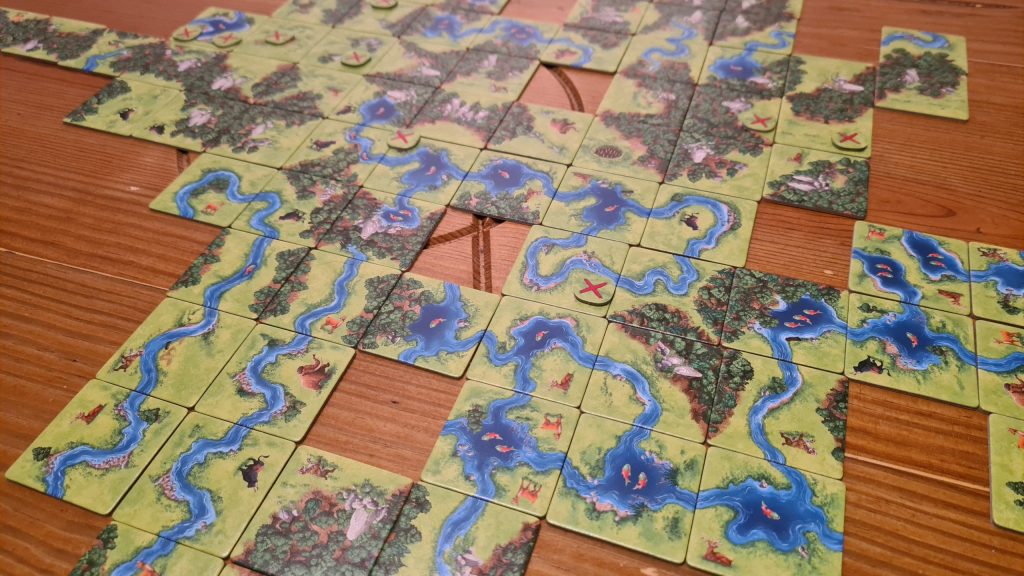Hans im Gluck has finally reprinted Carcassonne Hunters and Gatherers, which was originally released back in 2002 and has been out of stock for a number of years. Designed by Klaus-Jürgen Wrede, this version reimplements the classic Carcassonne, though it remains a tile placement game for 2 – 5 players. Gone are roads and cities, replaced with rivers, lakes and forests, which are full of prehistoric animals. However, should the mammoths have been left in the past without a reprint? Let’s find out!
Like in the original Carcassonne, players will be taking it in turns to build out the map of tiles. Each turn the active player starts by taking a land tile from the stack, before adding it to the map, adjacent to an existing tile. The rivers and forests on show cannot abruptly end, with this achieved by following the illustrations on the already placed tiles. Once placed the player will have the option of adding to unclaimed features with one of their meeples, referred to as tribe members, or one of their huts, depending on the feature. After this any completed features are scored, scoring points for the player with control via meeples.
Meeples can be placed on rivers, forests or meadows, while huts can only be added onto lakes. Rivers score based on their length and the number of fish in them and ending lakes, regularly scoring higher than roads in standard Carcassonne. Completed forests score similar to cities in Carcassonne, scoring 2 points per tile. After scoring rivers or forests any meeples on the feature are reclaimed by the player. Meeples placed onto meadows and huts are never reclaimed and score only at the end of the game.

New in Carcassonne Hunters and Gatherers are menhir tiles. When a player completes a forest that includes a menhir stone they trigger a bonus turn. The current turn is first fully resolved with any completed features scoring. Following this, the active player draws the top most menhir tile from the separate stack. The player then takes a second turn as normal placing this special tile, though this cannot trigger a further bonus turn. A range of the menhir tiles come with instant effects or scoring effects, from scoring the surrounding animals on meadows to scaring off pesky saber-toothed tigers. Either way, when the active player is finished play moves onto the next player.
The map of tiles grows in front of players, with features claimed and scored, until the main pile of tiles runs out. Note that the menhir tiles don’t need to run out for the end of the game to occur. At this point all meeples on rivers and forests are removed, not scoring anything. Meeples placed on meadows and huts however do now score. Meeples on meadows score based on the animals on the specific meadow. Mammoths score the most, being 3 points a pop. The bison like aurochs are worth 2 and deer are worth 1 point, though these are negated if saber-toothed tigers are also in the meadow – cancelling each other out as a pair. Huts score based on the entire river network, not just individual rivers, scoring 1 per fish in the network. Whoever has the most points after this is crowned the winner.
The menhir tiles allow players to have bigger than normal turns. Triggering them isn’t uncommon either. Unless players complete small 2 tile forests, chances are that a menhir stone will be part of a forest. Given that incomplete rivers and forests don’t score points at the end of the game these double turns, where a player has the potential to complete and score additional features, feel important. Not triggering further bonus turns also helps limit the impact, whilst giving players an interesting choice. A player could potentially use the bonus turn to finish another forest with a menhir stone to score the points or leave it for a future turn to again get a bonus turn.

The menhir tile abilities, more than the additional turns, can be a touch too much for brand new players. Frustratingly, there is very little way to intuitively know what tiles do, something not helped by tiles like the pit trap and the hunting trap looking similar. A few are instantly recognisable, such as the burning tree that scares away saber-toothed tigers, though they are still all extra rules. This results in a lot of checking the rulebook during menhir bonus turns.
It’s surprising that there isn’t a basic ruleset and then an advanced variant to play after a single game, as playing without the menhir tile powers but still using the additional turn rules alone would make the game more accessible for first time players. New players are already having to remember different ways to score than in the original, with huts and meeples to place.
As far as the components go Carcassonne Hunters and Gatherers is another solid entry for the franchise. The map that gets built out is full of little details from the animals in the meadows to the unique details on the menhir tiles. A few bits stand out though. The scoreboard is always useful, though there is an extra touch of including the animal scoring. It’s a small addition that makes the initial play a bit easier. X marked tokens are also included, which help during scoring. As deer are cancelled out by saber-toothed tigers, players can use these tokens on top of the tiles to make counting up the points earnt by meadows that bit easier.

Carcassonne has always had a spot of luck in it, thanks to the stack of tiles and the order they come out. While gone is the chance to get a lucky monastery tile with a perfect empty gap to place it, new swingy aspects have taken its place. With roads there was a standard amount of points based on the length, with longer scoring more. With the river scoring including fish, one player can build a river twice as long but be left behind in terms of points. The menhir tiles also add another aspect of luck, being a separate draw pile and some of them offering ways to gain points. While there is the extra slice of luck it isn’t to the extent a new player to the franchise would be able to win against an experienced player. Still, they might be able to get a bit closer score wise.
Carcassonne Hunters and Gatherers seems to be aimed towards fans of the series, rather than at enticing new players. Experienced players can swiftly understand the basic rules and are left only to contend with the impact of the menhir tile rules. It takes a couple of games before all of the menhir tiles have been used, which results in it taking a good few games before the rulebook can stay in the box. Getting past this and the core feeling of slowing building out a map, the almost puzzle-like gameplay that Carcassonne is loved for, is there. Unfortunately, while it is still entertaining, compared to the original, Carcassonne Hunters and Gatherers won’t get to the table as often, due to this initial barrier.
(Editor’s Note: Carcassonne Hunters and Gatherers was provided to us by Asmodee for the review. The game is currently available from local board game stores! Find your local store here.)

